|
|
|
Sort Order |
|
|
|
Items / Page
|
|
|
|
|
|
|
| Srl | Item |
| 1 |
ID:
171172
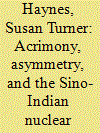

|
|
|
|
|
| Summary/Abstract |
While most contemporary analyses of South Asian nuclear dynamics acknowledge the presence of a strategic triangle between the region’s three nuclear players, the primary focus usually remains on the rivalry between India and Pakistan. Discussions of Sino-Indian relations remain limited. This is likely attributed to the stability in the two countries’ relations, yet it is worth asking why this stability exists and whether it is likely to continue in the future. Although China and India have an acrimonious relationship, their asymmetric nuclear capabilities and threat perceptions mitigate the danger of a traditional security dilemma. India may perceive China’s nuclear aggrandizement to be a security threat, but the same is not true of China, which has a vastly superior nuclear force and is largely shaping its nuclear-force structure in response to the threat it perceives from the United States. This dynamic makes a serious conventional or nuclear conflict highly unlikely.
|
|
|
|
|
|
|
|
|
|
|
|
|
|
|
|
| 2 |
ID:
171178


|
|
|
|
|
| Summary/Abstract |
The making of the Treaty on the Prohibition of Nuclear Weapons (TPNW) has put Austria and its involvement in nuclear disarmament in the spotlight. This study highlights several factors that led Austria to become a prominent voice in nuclear-disarmament debates. First, its involvement dovetails with the emphasis on humanitarian disarmament it has promoted since the 1990s. Second, a strong antinuclear identity pervades Austrian society. This “nuclear allergy” combines antimilitarism inherited from the Cold War and, more broadly, an aversion to nuclear power, including for energy purposes. These two considerations form the background to the increased activism of the Austrian Foreign Ministry on nuclear disarmament in international fora. But, equally, Austria’s crusade for the TPNW can be attributed to the engagement of a small team of diplomats implementing personal as well as national preferences in favor of disarmament.
|
|
|
|
|
|
|
|
|
|
|
|
|
|
|
|
| 3 |
ID:
171180
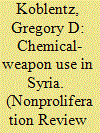

|
|
|
|
|
| Summary/Abstract |
International efforts to hold the government of President Bashar al-Assad accountable for the use of chemical weapons in the Syrian Civil War have entered a new phase. For the first time, the Organisation for the Prohibition of Chemical Weapons (OPCW), the international organization responsible for implementing the 1993 Chemical Weapons Convention, has been empowered to identify the perpetrators of chemical attacks in Syria. The Investigation and Identification Team (IIT), which was formed to conduct the OPCW’s new attribution mission, has announced its intention to investigate and identify the perpetrators of nine chemical attacks in Syria, including the April 7, 2018, attack in Douma. This article reviews recent efforts to attribute chemical attacks in Syria, describes what we know about the nine incidents to be investigated, summarizes what is known about the Syrian government officials, military commanders, and chemical-warfare scientists suspected of being responsible for these attacks, discusses what to expect during the next phase of the attribution process, and offers insights into how the international community can move beyond attribution to accountability. Accountability is necessary to provide justice for victims and to prevent future incidents by demonstrating that perpetrators of chemical attacks will be identified and punished.
|
|
|
|
|
|
|
|
|
|
|
|
|
|
|
|
| 4 |
ID:
171176
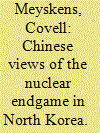

|
|
|
|
|
| Summary/Abstract |
This article examines Chinese views of North Korea’s nuclear-weapon program during the Donald J. Trump administration. It shows that China has portrayed itself as a responsible country that promotes regional stability, unlike the United States, which has engaged in military brinkmanship with North Korea. Some Chinese foreign-policy experts have asserted that Beijing should back Pyongyang in the event of war because of their shared history of humiliation by great powers, while others have favored working with other regional partners. Another theme in Chinese discourse about North Korea is that Pyongyang is an impetuous, ungrateful regime that impedes Beijing’s ability to attain its core interests of regional stability, economic development, and heightened global influence. This negative assessment of North Korea drove Beijing’s endorsement of stricter UN sanctions in 2017. While Beijing has punished Pyongyang for its wayward policies, China responded favorably to North Korea’s decision in April 2018 to stop nuclear tests and partake in international dialogue. Beijing seeks to help Pyongyang gradually disarm and develop its economy within a Chinese-led East Asian order. The article concludes by explaining how Beijing’s recent, more positive view of Pyongyang is likely to affect its support for American efforts to dismantle North Korea’s nuclear-weapon program.
|
|
|
|
|
|
|
|
|
|
|
|
|
|
|
|
| 5 |
ID:
171181


|
|
|
|
|
| Summary/Abstract |
Novichok agents are a class of nerve agents developed by the Soviet Union during the Cold War. In light of the use of a Novichok agent in Salisbury in March 2018, two sets of proposals to amend Schedule 1 of the 1993 Chemical Weapons Convention (CWC) have been put forth, one jointly by the United States, Canada, and the Netherlands, and the other by Russia. Both sets of proposals will be discussed and voted upon at the next Conference of States Parties of the Organisation for the Prohibition of Chemical Weapons (OPCW) in November 2019. If either set of proposals is approved, it will be the first time that the list of chemicals subject to verification under the CWC will have been modified. This viewpoint will discuss these proposals, and argue that, if adopted, the joint proposal and the portions of the Russian proposal upon which consensus can be reached would significantly strengthen the CWC by considerably expanding the coverage of its Schedule 1 and bringing Novichok agents firmly within the CWC’s verification system. We also argue that, since the OPCW Technical Secretariat did not deem the fifth group of chemicals proposed by Russia to meet the criteria for inclusion in Schedule 1, Russia should withdraw this part of its proposal from consideration. The proposals have also served an important purpose in clarifying the identity of the chemical agent used in the Salisbury incident, squarely placing it within one of the two families of Novichok agents described by the Russian chemical-weapons scientist and whistleblower Vil Mirzayanov. If either proposal is approved in November, it will be important to conduct a thorough assessment of key precursors for the synthesis of Novichok agents and assess the need to amend CWC schedules and national and multinational export-control lists accordingly.
|
|
|
|
|
|
|
|
|
|
|
|
|
|
|
|
| 6 |
ID:
171174
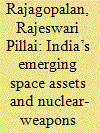

|
|
|
|
|
| Summary/Abstract |
Over the last five decades, India’s nuclear and space programs have gone through several phases, from collaboration to divorce to supportive. An interplay of two factors determined the nature of the relationship. One was the state of India’s nuclear-weapon program. The second was international conditions, especially India’s relationship with the nuclear-nonproliferation regime. In the early decades, because of the rudimentary nature of India’s nuclear and space programs, the relationship was collaborative, since the rocket technology being developed was a necessary adjunct to the nuclear-weapon program. Subsequently, as India’s rocketry capabilities and nuclear-weapon program began to mature and concerns about international sanctions under the non-proliferation regime began to grow, the two programs were separated. The Indian rocketry program was also divided, with the civilian-space and ballistic-missile programs clearly demarcated. After India declared itself a nuclear-weapon state in 1998 and the programs matured, the relationship has become more supportive. As the two programs mature further, this relationship is likely to deepen, as the nuclear-weapon program requires space assets to build a robust and survivable nuclear deterrent force.
|
|
|
|
|
|
|
|
|
|
|
|
|
|
|
|
| 7 |
ID:
171171
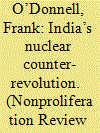

|
|
|
|
|
| Summary/Abstract |
The India–Pakistan near war of February–March 2019 highlights India’s ongoing evolution in strategic thought and practice since its emergence in 1998 as an overt nuclear-weapon possessor. These changes, involving an increasing willingness to engage in the intentional escalation of conflict with a nuclear-armed rival willing to be the first to use nuclear weapons, challenge certain academic assumptions about the behavior of nuclear-weapon states. In particular, they undermine the expectations of the nuclear-revolution theory—which anticipates nuclear and conventional restraint among nuclear-armed rivals through fear of mutual assured destruction—and the model of nuclear learning which underpins this theory, in which new nuclear-weapon states gradually absorb this restraint through policy-maker learning. This article explores how India’s learning pathway since 1998 has deviated from these expectations. India is instead pursuing its own “revolution,” in the direction of creating capabilities for flexible response and escalation dominance. It concludes by illuminating the similarities between Indian strategic behavior and contemporary practices of other nuclear-armed states, and suggests that New Delhi’s emerging de facto nuclear doctrine and posture is part of a broader empirical challenge to our current conceptions of the nuclear revolution and of nuclear learning.
|
|
|
|
|
|
|
|
|
|
|
|
|
|
|
|
| 8 |
ID:
171182


|
|
|
|
|
| Summary/Abstract |
As the United States and North Korea pursue negotiations on a “denuclearization” agreement, the two countries should consider initiating cooperative measures as a way to build confidence and encourage finalization of a complete agreement. Based on lessons from the initial engagements carried out under the Cooperative Threat Reduction (CTR) program in states of the former Soviet Union (FSU), initial cooperation should focus on safety and security, training, and infrastructure elimination. By offering to implement these initiatives now while negotiations are underway, the United States could gain additional insights into North Korean intentions. These early initiatives could be proposed without compromising the US maximum-pressure campaign on North Korea by using the current authorities of the CTR program and carefully designing specific exemptions that may be required for any agreed measures. If North Korea is truly interested in pursuing disarmament efforts, the initial cooperative projects would enable them to begin reaping potential benefits while negotiations continue with sanctions still in place. These initial proposals could also be expanded to include additional international partners such as Russia, China, South Korea, and Japan. Such programs and initiatives would support and supplement longer-term strategies to address North Korean weapons-of-mass-destruction challenges.
|
|
|
|
|
|
|
|
|
|
|
|
|
|
|
|
| 9 |
ID:
171179
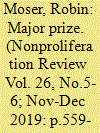

|
|
|
|
|
| Summary/Abstract |
This article focuses on the final years of South Africa’s nuclear-weapon program, particularly on the decision-making process leading up to the signature of the 1968 Treaty on the Non-Proliferation of Nuclear Weapons (NPT) by the South African government in 1991. In August 1988, after two decades of defiance, negotiations between the apartheid government and the NPT depository powers (the United Kingdom, the United States, and the Soviet Union) ensued at the International Atomic Energy Agency (IAEA) in Vienna. Despite South Africa being the only state to give up its indigenously developed nuclear weapons and subsequently join the nonproliferation regime, little is known about how the national position on NPT accession and IAEA safeguards evolved. Research carried out in multiple archives using hitherto untapped primary sources and interviews with key actors from several countries show how domestic and regional political dynamics influenced Pretoria’s position on entering the nonproliferation regime. In the process, the F.W. de Klerk government managed to skillfully exploit international proliferation fears to advance its own agenda, thereby connecting South African NPT accession with that of the neighboring Frontline States coalition of Angola, Mozambique, Tanzania, Zambia, and Zimbabwe.
|
|
|
|
|
|
|
|
|
|
|
|
|
|
|
|
| 10 |
ID:
171177
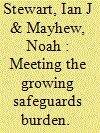

|
|
|
|
|
| Summary/Abstract |
The International Atomic Energy Agency (IAEA) faces challenges in fulfilling its safeguards mandate as a result of an expanding safeguards burden and a relatively static budget. This dilemma has been exacerbated by the additional burdens of implementing the Joint Comprehensive Plan of Action (JCPOA) in Iran, but would not go away if implementation of the JCPOA were to end. There are three main areas of opportunity for the Agency: (1) budgetary expansion tied to changes in staffing policies, (2) changes in safeguards approaches, and (3) technological innovation. Barriers and limitations are associated with each approach, and advancing any of them will face a difficult political environment in Vienna.
|
|
|
|
|
|
|
|
|
|
|
|
|
|
|
|
| 11 |
ID:
171173
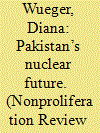

|
|
|
|
|
| Summary/Abstract |
In 2019, the geostrategic landscape of South Asia significantly changed. A crisis between India and Pakistan involved air strikes across international boundaries for the first time since the 1971 war. Pakistan came close to economic collapse, while India re-elected hawkish Narendra Modi as prime minister in a landslide. These developments, alongside the United States’ efforts to strike a deal to leave Afghanistan and rapidly improving US-India relations, portend new challenges for Pakistan’s security managers—challenges that nuclear weapons are ill-suited to address. Despite the shifting security and political situation in the region, however, Pakistan’s nuclear posture and doctrine seem unlikely to change. This article explores the roots of Pakistan’s reliance on the traditional predictions of the nuclear revolution, most notably the notion that nuclear-armed states will not go to war with one another, and argues that this reliance on nuclear deterrence is a response both to Pakistan’s security environment and to serious constraints on moving away from nuclear weapons toward an improved conventional force posture. Pakistan’s central problems remain the same as when it first contemplated nuclear weapons: the threat from India, the absence of true allies, a weak state and a weaker economy, and few friends in the international system. While 2019 may have been a turning point for other states in the region, Pakistan is likely to stay the course.
|
|
|
|
|
|
|
|
|
|
|
|
|
|
|
|
| 12 |
ID:
171175
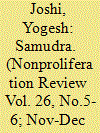

|
|
|
|
|
| Summary/Abstract |
India is advancing slowly toward operationalizing its nuclear triad. Its first nuclear-propelled ballistic-missile submarine (SSBN), the INS Arihant, conducted its maiden deterrent patrol in November 2018. However, doubts exist around the capability of India’s SSBN, the effectiveness of its command and control, and its effects on regional stability in South Asia. This article examines the history and future trajectory of India’s sea-based nuclear forces and describes how India seeks to maintain robust command and control over its undersea nuclear weapons.
|
|
|
|
|
|
|
|
|
|
|
|
|
|
|
|
|
|
|
|
|